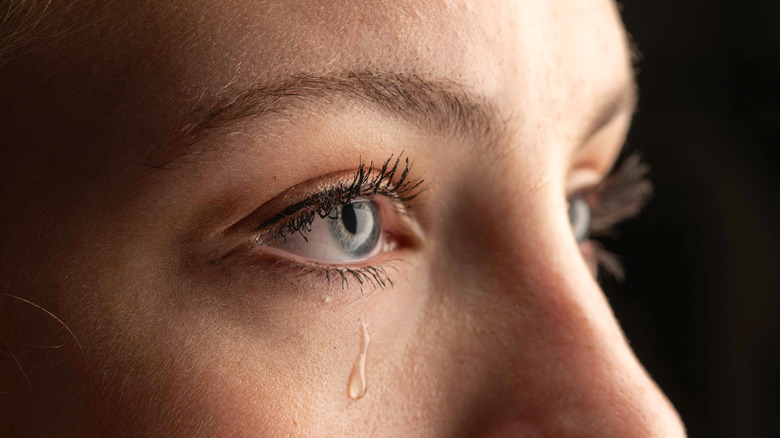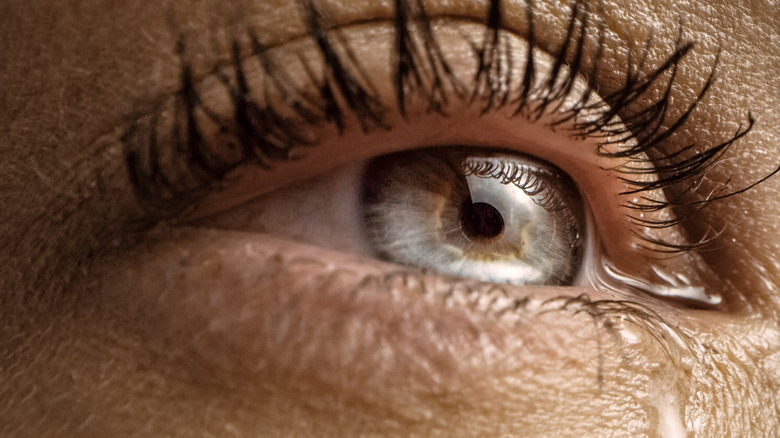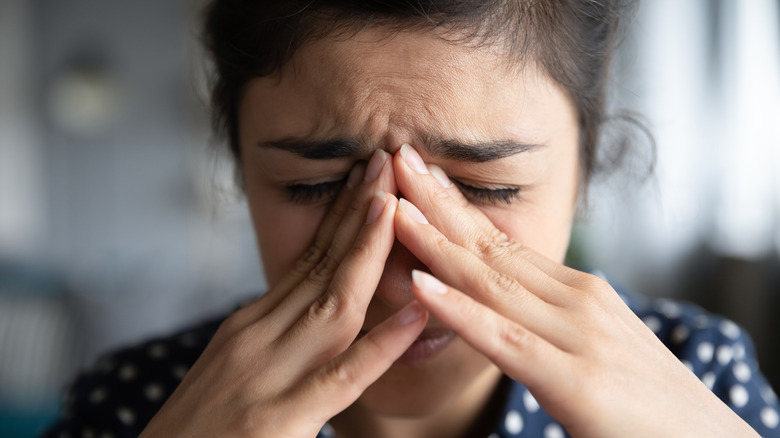When You Cry, This Is What Happens To Your Body
Human beings are the only animals that shed tears from emotion. While all mammals feel emotions and produce cries of distress and many species create tears to lubricate or clear debris from their eyes, it's believed that humans are the only living creatures that have evolved to weep as a means of emotional expression (via Smithsonian).
Author Jeffrey Masson wrote in his book, "When Elephants Weep: The Emotional Lives of Animals," that elephants often tear up while vocalizing pain or distress (via Dana Foundation). Darwin, too, wrote that zookeepers have historically observed emotional tearing in animals, but he ultimately went on to conclude that crying from emotions like joy, grief, or sorrow is uniquely present in human beings. And modern science agrees.
People have been speculating on the origin of tears for centuries (via Time). In 1662, the prominent Danish scientist Niels Stensen established that the lacrimal gland, situated just above the eyes, is responsible for tear production, which laid the foundation for scientists to begin understanding its evolutionary advantages, per Time. Stensen's theory was that tearing keeps the eyes moist — which, while true, is only the tip of the iceberg. Despite the ubiquity of crying, there's been surprisingly little scientific research dedicated to this universal human behavior, which remains at once a familiar and enigmatic phenomenon. But here's some of what we know so far about what goes on physically and physiologically when we cry.
The eyes are lubricated and protected
The human body produces three different types of tears: basal, reflexive, and emotional, each of which have their very own make-up, according to a 2018 literature review on the neurobiology of human crying. The lacrimal gland triggers the secretion of tears after receiving messages from both the autonomic nervous system and the brain's frontal lobe, reports the study authors.
Basal tears (also known as "continuous") are excreted in small amounts each time we blink to help lubricate and protect the cornea. Reflex tears are stimulated in larger quantities in response to irritants like dust, dirt, or the fumes of chopped onions, and helps to wash these away. The physiological function of emotional tears (also called "psychic") is a little less clear-cut (but will be explored throughout this article).
People whose eyes aren't sufficiently moisturized because they don't produce enough of these tears can develop a condition called "dry eye," which is mostly just uncomfortable but can, at worst, lead to loss of vision. An excess of tears, on the other hand, can aggravate the eyes, which is why they tend to become red and puffy after a lengthy sob session (via The Healthy).
You experience intense emotions
The tearing mechanism first evolved as a way for babies to get their mother's attention, explained Chip Walters, author and National Geographic Explorer, in his article for Scientific American Mind magazine. He described the tears from our early years "as a kind of rudimentary vocabulary that precedes a baby's first words." As we grow older, crying still serves as a mode of communication but also has an emotional function. Many people weep in isolation in response to intense emotions like grief, joy, sadness, or stress.
While basal and reflex tearing involves our peripheral nerves and brainstem, emotional crying activates higher brain structures (via Dana Foundation). When faced with a challenging situation, the amygdala — a part of the brain that drives our "fight or flight" response — produces a surge of emotions. The amygdala then communicates with the hypothalamus, a pea-sized part of the brain that's connected to the autonomic nervous system, which regulates bodily functions like temperature, hunger, and of course, crying (via Self).
Research shows that one of the most common emotional triggers for crying is the feeling of powerlessness or helplessness, often in combination with strong emotions like sadness, anger, fear, or disappointment. Based on therapy-style interviews, Cord Benecke, a clinical psychologist and professor at the University of Kassel in Germany, found that noncrying people experienced more aggressive emotions, such as rage, anger and disgust, than people who cry (via Time).
We feel close to others
Besides their role in communication, tears have an important social function: They let the people around us know that we feel close to them, fostering an empathetic response and promoting bonding and trust (via The Healthy). We don't usually allow ourselves to be vulnerable around strangers in this way, and vulnerability plays a key role in forging emotional connections. Research highlights that the same neuronal areas of the brain start to fire when we witness someone crying as when we tear up ourselves, proposing that human beings have evolved to a point where crying automatically triggers compassion and empathy (via Time).
"Adult tears, like vocal crying, mainly convey the message, 'I need you, help me!'" Ad Vingerhoets, an expert on crying and professor at Tilburg University in the Netherlands, told The Healthy. "Crying signals to yourself and other people that there's some important problem that is at least temporarily beyond your ability to cope," Jonathan Rottenberg, an emotion researcher and professor of psychology at the University of South Florida, told Time.
Additionally, William Frey, a biochemist who carried out groundbreaking crying research in the 1970s and 1980s, found that emotional tears are composed of different chemicals than those people shed when they chop onions or get poked in the eye, which may provide a clue about their function. In particular, they contain more protein than reflex tears, making them stickier so that they stay on a person's face longer and are more visible to others (via Time).
Your facial muscles are engaged
The production of tears is just one of several important components of emotional crying, noted the study authors of "The Neurobiology of Human Crying." Crying involves the activation of several facial muscles, they added, which work together to produce the very recognizable characteristics of a sobbing face: puckered eyebrows, crinkled eyes, flared nostrils, depressed lip corners, a widened mouth, and quivering chin.
The New Republic described the meme-ified "ugly cry" as weeping "so fervidly that one's face contorts in ostensibly unattractive ways." Most of us are likely to have experienced this at some point — the feeling of being so overcome by emotion as we erupt into a deep, raw sob, momentarily forgetting what our faces are doing. Blood rushes to the head, the eyes redden and puff up, and the sudden build-up of tension causes the facial muscles to strain in sometimes peculiar ways. The publication explained that this type of crying "summons expressions that render us strange to ourselves and to others, largely because we've relinquished our bodies to wild, emotive energy."
Your nose starts to run
A snotty nose is synonymous with sobbing. Yes, indulging in a good cry can get pretty messy. The biology behind this is pretty straightforward. Tears drain out of your tear ducts, which are situated underneath your eyelids, and travel down into your nose via the nasolacrimal ducts, Dr. Erich Voigt, director of the division of general otolaryngology at NYU Langone Medical Center, told Self. There, they mix with the mucous and other substances like allergens or blood inside your nose. This fluid then drips out of the opening of the nostrils.
"You're not making more mucus, it's just the tears draining and mixing with the mucus (that's already there)," Voigt explained. When tears are produced more rapidly and in greater quantity than they're drained, they spill down our face and can create that stuffed-up feeling in our nose.
"In normal situations, the sinonasal mucosa (the lining of your nasal and sinus cavities) can produce up to a quart of mucus per day," Dr. Ahmad R. Sedaghat, an otolaryngologist at Massachusetts Eye and Ear Infirmary in Boston, told Prevention. "This mucus normally flows to the back of the nose, down the throat and then is swallowed."
You get a lump in your throat
The sensation of a lump in the back of the throat (known medically as "globus pharyngeus") is often a tell-tale sign of an impending crying jag. Researchers claim that it's caused by a struggle between the sympathetic and parasympathetic nervous systems over the glottis, or opening between the vocal folds, and often occurs when a person is trying to hold back their tears (via Self).
The sympathetic nervous system controls the body's flight-or-fight response. During a stressful or threatening situation, it puts a halt to unnecessary functions like digestion and urination in order to conserve energy so that you're able to respond to a threat. The body then requires more oxygen and gives rise to an increase in breathing rate, causing the glottis to expand to let more air in. The parasympathetic division, on the other hand, tries to bring the body back to normal, causing the glottis to close. In essence, that lump-in-the-throat sensation stems from the constriction of different muscles trying to open and close the glottis at the same time.
Your breathing pattern changes
Breathing is another noticeable aspect of our physiology that changes when we cry. The diaphragm pulses, moving up and down. This disrupts our regular breathing rhythm, causing varying levels of oxygen and shortness of breath between sobs, which is why people tend to take deep inhalations while weeping (via PsychCentral).
A 2020 study published in the journal Emotion showed that crying helps people regulate their breath during stressful events, facilitating coping and recovery. Researchers found that participants who cried were better able to maintain control over their breathing than non-criers.
"The major caveat with this research is that we don't know if these reactions are typical in real-world settings where you might be crying because of grief or loss, for example, or if there are differences if someone else is present with you when you cry," study author Leah Sharman told PsyPost. In other words, there might be something different about the way people cry and breathe outside of a laboratory setting.
Your body goes into fight-or-flight mode
At the root of many of the physical changes we observe when people cry is the body entering into the fight-or-flight mode. Researchers have consistently observed increases in sympathetic activity associated with emotional tearing. Some people even experience body shakes while others may notice changes to the vocals like a higher pitch or a more nasal tone (via "The Neurobiology of Human Crying"). Indeed, sobbing is a full-bodied affair, which explains why it can, at times, feel like an actual workout, leaving us both physically and emotionally drained.
According to the "arousal hypothesis", crying allows our bodies to physically prepare for a threatening or stressful situation. It's also used to signal to our social group that we feel unhappy and something's out of sorts, and that an aversive event is taking place or about to take place in the body or environment (via Dana Foundation).
Heart and breathing rate slow down
Crying doesn't always go hand in hand with feeling stressed. Sometimes, letting the tears flow can help release emotional pain and make us feel better, which is why theologian Albert Richard Smith stated that "tears are the safety valves of the heart when too much pressure is laid upon it" (via Dana Foundation).
Some researchers have put forward the theory that crying is an adaptive response to stress. In a scientific literature review in Frontiers in Psychology, the authors argued that weeping is a self-soothing behavior that calms the body down and alleviates the physical tension brought about by overwhelming emotions. From this perspective, the mechanism of crying is governed by our parasympathetic nervous system, which causes our heart rate and breathing to slow down, our blood pressure to drop, and muscles to relax.
While there's strong evidence to support the notion that crying occurs in a state of heightened physiological arousal, findings for parasympathetic activity are less consistent and remain somewhat ambiguous. But it's possible that there's some truth to both theories. Research indicates that the "resolution of crying" is ultimately what's linked to increases in parasympathetic activity like a decrease in heart and breathing rate.
The body returns to an equilibrium state
An emotional episode can be deeply complex and varied: You might find yourself traversing a number of different emotions from despair to elation to relief. It's been suggested by some scientists that the production of tears is both physiologically arousing and a means of restoring emotional balance, as a 2014 report in Frontiers in Psychology revealed. According to this theory, crying begins in fight-or-flight mode and ends in a more restful state, serving as a kind of "homeostatic mechanism."
Psychologists Jay S. Efran and Thomas Spangler espouse this two-factor theory (via Dana Foundation): During the initial stages of crying, physical tension is created in the body due to particular thoughts and emotions, while in the second stage, there's a shift to relief and recovery. There's no definitive evidence for this; however, scientific research and anecdotal reports lend credence to the idea that both types of responses are at play at different points during a sob.
"It seems that crying is associated with intense physiological arousal that can be connected to both positive and negative emotions, and occurs just after the peak of the emotional experience as the individual is beginning to experience the release of that emotion," Dr. Lauren Bylsma, an assistant professor of psychiatry at the University of Pittsburgh School of Medicine, told The Healthy.
Your brain produces feel-good hormones
Sometimes, there's nothing more cathartic than a good bawl. It's not surprising, then, that when you tear up, your body produces an endorphin called leucine-enkephalins, a natural pain-reliever that's released when your body is under stress (via Self). "So people start to feel a sense of relief," Dion Metzger, an Atlanta-based psychiatrist, told Self. Other hormones released during crying include oxytocin and endogenous opioids, which also help alleviate physical and emotional discomfort, according to a 2014 study.
Research published in the Journal of Social and Clinical Psychology reinforced the hypothesis that our tears give rise to feel-good chemicals, revealing that most men and women from 35 different countries reported feeling better after a weep. But this cathartic effect isn't universal. Another study published in the Journal of Research in Personality showed that the mood-boosting benefits of crying are ultimately dependent on an individual's social environment and characteristics, and that people with mental health issues like depression or anxiety are less likely to experience any benefits from crying.
Nevertheless, these findings are yet to be confirmed. "There is really no good evidence showing the health benefits of crying," Dr. Rottenberg told The Healthy. "These ideas persist because there is almost no science on the physiology of crying, and our folk beliefs, which teach that it is good for health to cry, fill this void."
Does crying purge toxins?
The idea that crying has detoxifying effects has been around for centuries (via Time). Some believe that a crying spell not only helps rid you of bad vibes but may help purge the toxins from your body. And research confirms that this is more than just an urban legend. A 2013 study in Experimental Eye Research found that an antibacterial protein in emotional tears called lysozyme — also found in saliva, semen, mucus, and breast milk — kills the harmful molecules in our blood, protecting our eyes from infections. A 2011 study published in the journal Food Microbiology found the antimicrobial potency of tears is so strong that they can even defend the body against anthrax contamination.
But research around this topic remains limited. It's difficult to replicate these findings due to the challenge of mimicking emotional scenarios in a lab and the ethical issues of eliciting crying in natural settings. "It's very challenging to have individuals cry to emotional stimuli naturally while having their tears collected, and most of the tears are actually absorbed in the nasal passages and cannot be collected," Dr. Bylsma, an assistant professor of psychiatry at the University of Pittsburgh School of Medicine, told The Healthy.
Crying women and babies have physiological effects on men
Perhaps the fairytale story of Rapunzel was on to something: women have magical tears. At least, research seems to suggest that female tears have marked physiological effects on men.
A 2011 study in the journal Science hypothesized that women's tears contain a substance that decreases sexual arousal and has an inhibitory effect on testosterone levels in men (via National Geographic). It showed that male participants who sniffed women's emotional tears were less aroused and interested in the female subjects than when they sniffed a neutral placebo solution. So, according to the findings, the sight (or smell) of a crying woman is not only a turn-off but dials down male aggression.
Interestingly, a 2012 study in the journal Hormones and Behavior found that simulated baby's tears also modified male testosterone levels. Men who were given a chance to provide comfort to the doll experienced a drop in testosterone levels following the interaction, whereas those who weren't able to provide a nurturing response saw an increase in testosterone, demonstrating that the sight of tears can also have an impact on male hormones.













